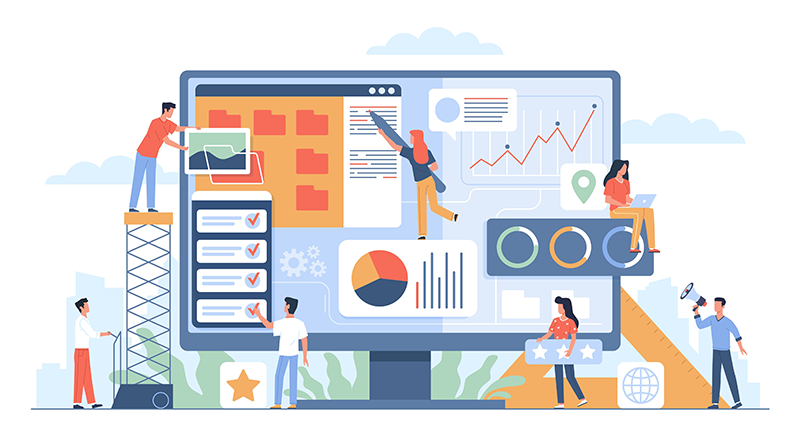The concept of DevContentOps may seem like a new invention. However, the interactions that spawned this approach to content and software applications have been happening for quite some time.
Content management systems, in particular headless ones, and DevOps have provided businesses with different ways to manage the modern digital experiences that consumers have demanded from them. Yet, not every company has been able to realize meaningful success. DevOps and the headless CMS are on an inevitable collision course, but some brands may be too slow to notice and see results.
In this article, we’ll outline what has been restricting the successful combination of the headless CMS and DevOps practices and highlight some of the requirements for architecting a DevContentOps environment.
Recapping DevContentOps
First of all, we need to recap what DevContentOps is and why it’s necessary. DevContentOps introduces the headless CMS and content into the traditional DevOps lifecycle. The modern content-driven digital experiences which businesses need to create today aren’t possible with DevOps alone. Content teams, as well as the tools and processes they rely on, are usually left out of the equation.
In order to realize the benefits of DevOps for digital experience applications, content authors need to be able to collaborate with developers and IT operations. Traditional DevOps can fall short of the support required for mobile apps, e-commerce experiences, omnichannel websites, and more. In addition, every modern software application also requires some content integration, even though this is sometimes overlooked. With DevContentOps, enterprises can combine content with DevOps to realize true enterprise innovation.
But to leverage DevContentOps, organizations need to start with a DevContentOps-Ready CMS.
What Is a DevContentOps-Ready CMS?
Headless architecture has transformed the content management world and enabled businesses to realize their potential in various ways. However, being headless isn’t the only requirement for a DevContentOps-ready CMS.
Can any CMS be DevContentOps-Ready? The short answer is no.
First of all, let’s look at the traditional CMS platforms. Due to their lack of headless architecture and API connectivity, these platforms automatically struggle to implement a DevContentOps workflow and don’t support the speed and scalability required for modern content applications.
Also, many headless and hybrid headless platforms are unable to support DevContentOps because of their underlying architecture. These systems are typically built on top of SQL, NoSQL, or JCR repositories that struggle to scale and to flow content and code across environments. As a result, updating environments requires export/import processes resulting in content and code freezes.
A DevContentOps-ready CMS should incorporate a few things. In particular, it should support a distributed Git-based repository that enables content and code to live together and for developers and marketers to collaborate while building code and content together, and to not interfere with each other when doing their own thing. Furthermore, a DevContentOps-ready CMS should provide APIs to easily integrate with CI/CD workflows and tools.
Read More: DevContentOps-Friendly CMS: What to Look For
What is a DevContentOps Environment?
A DevContentOps environment must incorporate a few things. First of all, the infrastructure:
Git-based Repository
A Git-based CMS uses a Git repository that stores files for managing content. Git-based infrastructure is essential for DevContentOps, due to a powerful versioning system and its naturally distributed architecture that facilitates easily moving code forward from development and testing to production. At the same time, content can be easily moved back from production environments to lower environments and avoid code and content freezes that slow down both software-based feature development and content authoring and publishing.
Read More: What is GitOps?
Headless Architecture
A DevContentOps environment also needs a CMS that supports an API-first headless approach. Easy integration of the CMS with traditional DevOps tools and processes is key to streamlining content-based software application development. These tools are essential for developers to build, test, and release content-focused applications. Furthermore, DevContentOps requires the continuous merging of code and content changes to remove the conflicts that arise during DevOps development, testing, and release cycles.
Features of a DevContentOps Environment
While underlying infrastructure is essential as a foundation for DevContentOps, some of the key benefits of a DevContentOps environment include:
CI/CD: Support for DevOps tools also means that a DevContentOps environment should support Continuous Integration and Continuous Delivery/Deployment so that code can be moved forward through environments all the way to production, while content can be moved back to lower environments. As a result we can eliminate any possibility of content freezes and thereby extend CI/CD toward CI/CD/CP (Continuous Publishing).
Team Collaboration: Technology can support better collaboration, but a DevContentOps environment should also provide a culture that enables developers, IT operations, and content managers to work together.
Developer Freedom: Developers should be able to use the frameworks and technologies they want for building applications, rather than be restricted by what has to be managed in the CMS or the types of DevOps tools that can be integrated.
Distributed Repository: Code, content, and configuration should all be managed in a distributed repository (like Git) to allow for packaging and releasing in a single publishing cycle.
Continuous Publishing: Content should be allowed to be published continuously without interruptions due to ongoing software development, test and release cycles.
Why You Should Start Building Your DevContentOps Environment Today
Keeping up with these customer demands as well as the need to continue innovating and introducing new types of content-rich digital experiences and software applications means that businesses require new approaches.
Traditional CMS platforms place limitations on what developers and content authors can do to create digital experiences. They are restricted to particular frameworks, lack the capabilities that developers need to support modern tools and CI/CD processes, and offer little to no team collaboration. Most headless platforms, on the other hand, also struggle due to their use of traditional database-oriented architectures that impose bottlenecks, resulting in content and coding workflow interruptions. Ultimately, neither of these options are suitable for building the future of content-driven applications in an agile manner using modern tools and methods.
DevContentOps provides a modern approach that successfully blends content with traditional DevOps to realize benefits such as shorter development cycles, frictionless development, and seamless collaboration. As a result, organizations can deliver the digital experiences that their audiences want without handicapping the content authors, IT operations, and developers that enable them.

 Mike Vertal
Mike Vertal




